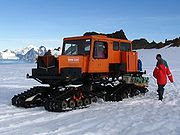 |
| SNOWMOBILE |
How to adapt vehicles to ice and snow
conditions?
In extreme ice and snow conditions,
like the arctic, planes, trucks, tractors and buses have to be adapted.To reach and harvest oil and gas in
the bitter wasteland of the Arctic regions where the land is bare in the
summer. On the top it is muddy and boggy and frozen solid of several hundred
metres underneath. In the winter the whole area is covered with snow and ice,
temperature reaching -50oC with blizzards raging. The drilling team have to
have vehicles which are totally reliable in those conditions.
==================================================
PLEASE BE SO KIND AND CLICK ON ADVERTS. THANK YOU.
==================================================
Their trucks and support vehicles are
fitted with enormous low-pressured tyres. This spreads the weight of the
vehicle over a larger area. In both conditions, snow and mud, it stops the
vehicle to be bogged down. It also prevents more damage to surface than
necessary. These vehicles are used for transporting extreme loads like drilling
rigs, supplies and exploration equipment.
A big-wheeled snow vehicle with
36,000 kg load will have ground pressure of 2.4 kg/cm2.and has a speed of 40
km/h
A tracked vehicle with the same load
will have a ground pressure of 0.33 kg/cm2 and a speed of 15 km/h. No doubt it
is slower but it is the ground pressure which is really of importance.
Tracked vehicles are used in the
Antarctica and it carries supplies plus pulling large cargo sledges. The supplies
to the scientific research station are once a year which are sent by ship and
then transported over land for several kilometres.
The first who tried to use this
method was Captain Scott in 1911. Unfortunately, his tractor was braking down
too many times and eventually he abandoned it. Scott also refused to use
dog-sleds and therefore they man-hauled their supplies.
 |
| SNO-CAT |
The most famous polar vehicle is the
big sno-cat. This was also used on the Commonwealth Trans-Antarctic Expedition
in 1955-58. It weighs 3175 kg but is capable of carrying one tone of supplies
and pulling two sledges with two tones each. The sno-cat has two tracked units,
which are called pontoons, at the front and two at the rear. They are
independently sprung and designed to enable it an almost 100 % traction. The
front pontoons are steered to the left; the rear one automatically steers to
the right; all four pontoons follow the same arc which enables the vehicle a
maximum manoeuvrability. The sno-cat can be fitted with a straight blade or a
curved blade. The range of blades is from 2.6m with 6 positions and up to 3.5m
blade with 12 positions.
PREPARATION OF PISTE
To satisfy the skiers and make them
come back year after year, the slopes (pistes) have to be in perfect condition.
No effort is spared. After the skiers left the slops the maintenance team go
over with their powerful, low-body and wide-tracked vehicles. These vehicles
are with pusher blades in the front to shift the snow to the part which worn
thin from skiers. At the rear rollers and smoothing blades to compact the new
snow. It leaves the slope clean, smooth and with a firm surface. A tiller,
mounted at the front will scoop up excessive snow and blows it 40m away with
the ejector chute.
Small machines clear and repair the
cross-country trails. Also tracks to and from ski-lifts.
Large machines which have a width of
five metres smooth and surface the main slopes. This means 70,000 square metres
are treated every hour.
The black runs are surfaced just the
same but on a surface too steep to drive on. The tractor is fitted with a 650
metre winch cable which enables the driver to go up or down in safety.
In Canada, American Rockies,
Scandinavia or the Alps a snowmobile is used to go to the store for supplies or
for the weekend up to a cabin. The forest ranger, border guard and member of
the mountain rescue team use it for work. There are also racing snowmobiles
capable of up to 190 km/h.
The current sports model is sleek,
low, aerodynamic body with a two-cylinder engine of 350-700cm3. On the front
there is a pair of skies which is steered by the handlebar. The broad rubberised
track under the rear, two-third, of the machine is to provide propulsion. They
are also fitted with wind-deflecting shields, powerful headlights and electric
hand-warmers for drivers and passengers. You definitely need padded, insulated
windproof clothing, helmet, face-mask and goggles. These models can reach a
speed up to 100km/h.
Snowmobiles were first invented by
Canadian Joseph Amand-Bombardier in 1930. It was designed to carry troops. It
was fitted with ski-like steering runners at the front. A petrol engine was
fitted to a half-track drive at the back. Bombardier-Nordtrak is still a
leading manufacturer.
No comments:
Post a Comment